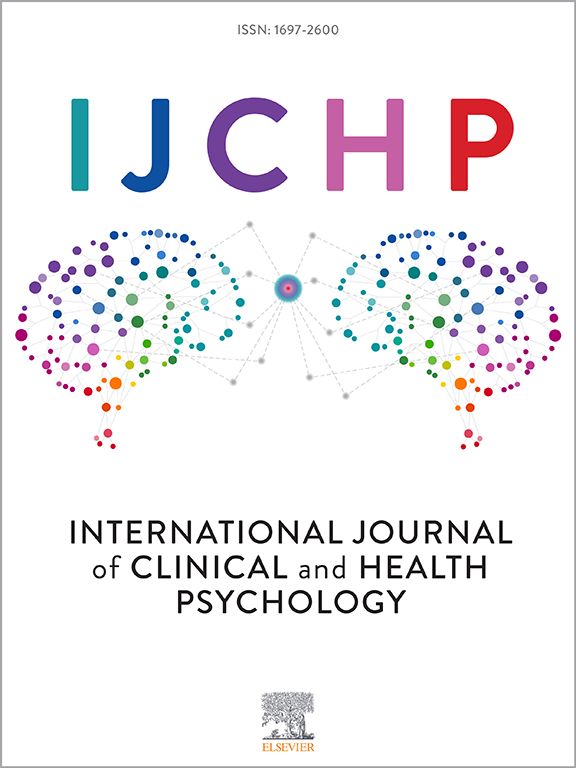厌恶紧张:一种新的虚拟现实范式来评估青少年和青年边缘型人格障碍患者的情绪唤醒
IF 4.4
1区 心理学
Q1 PSYCHOLOGY, CLINICAL
International Journal of Clinical and Health Psychology
Pub Date : 2025-04-01
DOI:10.1016/j.ijchp.2025.100583
引用次数: 0
摘要
高情绪唤醒(EA)是边缘型人格障碍(BPD)的核心特征。虽然虚拟现实(VR)在治疗基于情绪的障碍方面显示出希望,但VR在BPD中的应用研究仍然有限,特别是在青少年中。本研究旨在验证一种新的基于vr的厌恶张力范式,用于评估青少年和年轻成人BPD症状的EA。方法在一项多模式研究中,我们调查了厌恶紧张的有效性:我们调查了62名有BPD症状的患者和62名年龄在13-25岁的健康对照(HC),他们完成了两次VR会话(应激/对照条件)。每次会议都包括一个改编的特里尔社会压力测试(TSST),然后是一个网络球范例。在会议期间进行主观EA评分和生理测量。结果BPD组在两种情况下的EA水平均明显高于HC组。两组在TSST后均表现出EA峰值,而HC组在Cyberball期间均表现出EA降低。BPD组在应激状态下保持较高的EA水平。生理数据部分支持这些发现,BPD组表现出更高的心率,特别是在压力条件下的赛博球。厌恶张力范式成功地区分了BPD和HC组,捕获了主观和生理反应。BPD组在应激状态下的持续EA与特征性情绪失调模式一致。虽然观察到特定任务的影响,但TSST引发的反应比Cyberball更强烈,该范式有效地模拟了受控VR环境中现实生活中的压力源。结论:本研究验证了厌恶张力法作为评估青少年和青年BPD症状EA的有效工具。基于虚拟现实的方法在实验控制和生态有效性方面具有优势,在临床环境中显示出诊断评估和治疗干预的潜力。本文章由计算机程序翻译,如有差异,请以英文原文为准。
aVeRsive tension: A new virtual reality paradigm to assess emotional arousal in adolescent and young adult patients with symptoms of borderline personality disorder
Background
High emotional arousal (EA) is a core feature of borderline personality disorder (BPD). While virtual reality (VR) has shown promise in treating emotion-based disorders, research on VR applications for BPD remains limited, especially in adolescence. This study aimed to validate a novel VR-based aVeRsive tension paradigm for assessing EA in adolescents and young adults with BPD symptoms.
Methods
In a multimodal study, we investigated the validity of aVeRsive tension: We surveyed 62 patients with BPD symptoms and 62 healthy controls (HC) aged 13–25 years who completed two VR sessions (stress/control condition). Each session included an adapted Trier Social Stress Test (TSST) followed by a cyberball paradigm. Subjective EA ratings and physiological measurements were taken during the sessions.
Results
The BPD group showed significantly higher EA levels compared to HC across both conditions. While both groups exhibited peak EA after TSST, HC demonstrated EA reduction during Cyberball in both conditions. The BPD group maintained elevated EA levels in the stress condition. Physiological data partially supported these findings, with the BPD group showing higher heart rates, particularly during Cyberball in the stress condition.
Discussion
The aVeRsive tension paradigm successfully discriminated between BPD and HC groups, capturing both subjective and physiological responses. The sustained EA in the BPD group during stress conditions aligns with characteristic emotion dysregulation patterns. While task-specific effects were observed, with TSST eliciting stronger responses than Cyberball, the paradigm effectively simulated real-life stressors in a controlled VR environment.
Conclusion
This study validates the aVeRsive tension protocol as a promising tool for assessing EA in adolescents and young adults with BPD symptoms. The VR-based approach offers advantages in experimental control and ecological validity, showing potential for both diagnostic assessment and therapeutic intervention in clinical settings.
求助全文
通过发布文献求助,成功后即可免费获取论文全文。
去求助
来源期刊

International Journal of Clinical and Health Psychology
PSYCHOLOGY, CLINICAL-
CiteScore
10.70
自引率
5.70%
发文量
38
审稿时长
33 days
期刊介绍:
The International Journal of Clinical and Health Psychology is dedicated to publishing manuscripts with a strong emphasis on both basic and applied research, encompassing experimental, clinical, and theoretical contributions that advance the fields of Clinical and Health Psychology. With a focus on four core domains—clinical psychology and psychotherapy, psychopathology, health psychology, and clinical neurosciences—the IJCHP seeks to provide a comprehensive platform for scholarly discourse and innovation. The journal accepts Original Articles (empirical studies) and Review Articles. Manuscripts submitted to IJCHP should be original and not previously published or under consideration elsewhere. All signing authors must unanimously agree on the submitted version of the manuscript. By submitting their work, authors agree to transfer their copyrights to the Journal for the duration of the editorial process.
 求助内容:
求助内容: 应助结果提醒方式:
应助结果提醒方式:


